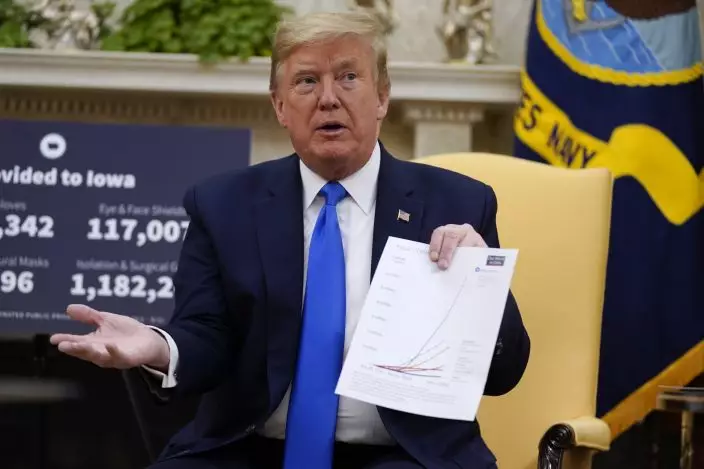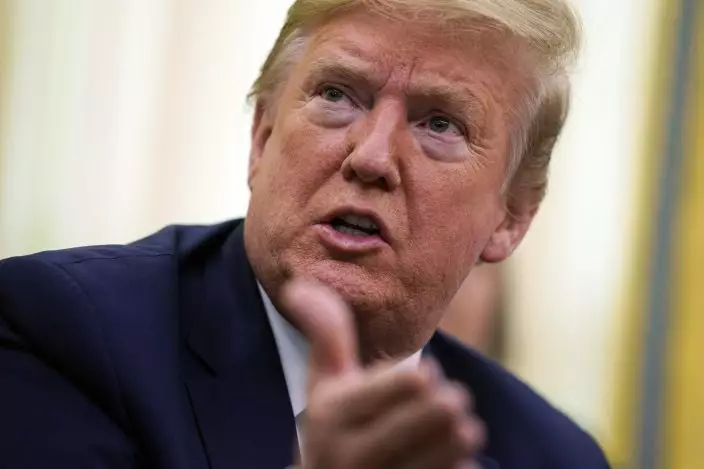Truth often takes a beating when President Donald Trump talks about his administration’s response to the coronavirus and the subsequent death toll in the U.S. This past week was no exception.
Over the weekend, the president claimed strong marks for himself for the handling of the pandemic after imposing a “very early ban of people from China." It actually wasn’t a total ban and had plenty of gaps in containment. One of the government's top health officials has described the China restrictions as too little, too late.
Trump also asserted that the United States is on par with Germany in keeping down COVID-19 deaths, which is not the case in mortality reports. And he's brushed off projections that deaths in his country will double from earlier forecasts, misrepresenting how the numbers were calculated.

President Donald Trump speaks during a meeting with Gov. Kim Reynolds, R-Iowa, in the Oval Office of the White House, Wednesday, May 6, 2020, in Washington. (AP PhotoEvan Vucci)
These distortions emerged over the past week alongside his relentless bragging about the U.S. testing system, which failed in the crucial early weeks and remains globally subpar.
A look at Trump's remarks, also covering his former national security adviser Michael Flynn:
TRAVEL RESTRICTIONS

Juliet Daly, 12, rides her bike outside her home in Covington, La., Thursday, April 30, 2020. A team of pediatric cardiology specialists found that Juliet had acute fulminant myocarditis (AFM), an uncommon heart condition that tends to present with sudden onset acute heart failure, cardiogenic shock or life-threatening arrhythmias. A nasal swab confirmed that Juliet was also COVID-19 positive and that she had a second viral infection – adenovirus. (AP PhotoGerald Herbert)
TRUMP: “We are getting great marks for the handling of the CoronaVirus pandemic, especially the very early BAN of people from China, the infectious source, entering the USA.” — tweet Sunday.
THE FACTS: This is one of Trump’s favorite exaggerations, asserting that travel restrictions he imposed on China in late January had averted much of the virus' entry into the U.S.
In fact, Trump didn’t “ban” all the people infected with coronavirus from entering the U.S. from China. There were many gaps in containment and initial delays in testing, leading to the U.S. rising to No. 1 globally in the number of people infected by COVID-19.

President Donald Trump speaks during an event to sign a proclamation in honor of World Nurses Day, in the Oval Office of the White House, Wednesday, May 6, 2020, in Washington. (AP PhotoEvan Vucci)
His order temporarily barred entry by foreign nationals who had traveled in China within the previous 14 days, with exceptions for the immediate family of U.S. citizens and permanent residents as well as American citizens.
In addition, Dr. Anne Schuchat, the No. 2 official at the U.S. Centers for Disease Control and Prevention, told The Associated Press earlier this month the federal government was slow to understand how much coronavirus was spreading from Europe, which helped drive the acceleration of outbreaks across the U.S. in late February. Trump didn't announce travel restrictions for many European countries until mid-March.
“The extensive travel from Europe, once Europe was having outbreaks, really accelerated our importations and the rapid spread,” she told the AP. ”I think the timing of our travel alerts should have been earlier.”

Juliet Daly, 12, plays with her brother Dominic, 5, in their family home in Covington, La., Thursday, April 30, 2020. A team of pediatric cardiology specialists found that Juliet had acute fulminant myocarditis (AFM), an uncommon heart condition that tends to present with sudden onset acute heart failure, cardiogenic shock or life-threatening arrhythmias. A nasal swab confirmed that Juliet was also COVID-19 positive and that she had a second viral infection – adenovirus. (AP PhotoGerald Herbert)
TRUMP: “Compare that to the Obama/Sleepy Joe disaster known as H1N1 Swine Flu. Poor marks ... didn’t have a clue!” — tweet Sunday.
THE FACTS: His suggestion that former President Barack Obama and his vice president, Joe Biden, were oblivious and did nothing during the 2009 H1N1 pandemic, initially called “swine flu,” is wrong.
Then, the Centers for Disease Control and Prevention’s flu surveillance network actually sounded the alarm, spotting two children in California who were the first diagnosed cases of the new flu strain. About two weeks later, the Obama administration declared a public health emergency and CDC began releasing anti-flu drugs from the national stockpile to help hospitals get ready. In contrast, Trump declared a state of emergency in early March, seven weeks after the first U.S. case of COVID-19 was announced.
DEATH COUNTS
TRUMP on pandemic deaths: “Now, Germany — we’re very close to Germany. We have a very good relationship with Germany. Germany has done very good. They have a very low mortality rate like we do. We have a low mortality rate also." — remarks Thursday in meeting with Gov. Greg Abbott, R-Texas.
THE FACTS: The U.S. is not in Germany's league in this regard.
The U.S. is experiencing far more reported COVID-19 deaths as a proportion of its population than is Germany. The U.S. has reported COVID-19 deaths at a rate of 234 per 1 million people. For Germany, that rate is 90 deaths per million. The U.S. surpasses many other countries in reported deaths per million, too, and it leads the world in deaths from the virus overall.
Because countries track COVID-19 deaths somewhat differently, exact conclusions can't be reached when comparing nations.
The mortality rate is a different measure from deaths per million. It refers to what percentage of people who get the disease die from it.
The answer is as yet unknown, and there are several reasons for that.
First, the count changes every day as new infections and deaths are recorded. More important, every country is testing differently. Knowing the real denominator, the true number of people who become infected, is key to determining what portion of them die.
Some countries, the U.S. among them, have had trouble making enough tests available. A test shortage means the sickest get tested first. Even with a good supply of tests, someone who’s otherwise healthy and has mild symptoms may not be tested and thus go uncounted.
TRUMP: “And, frankly, if you took New York out of the equation, we would really have a low mortality rate.” — remarks with Abbott.
THE FACTS: New York, being part of the U.S., cannot be subtracted from it to make the numbers look better.
It's true that New York has experienced far more COVID-19 deaths than has any other state.
TRUMP, asked about a White House-endorsed model showing 134,000 deaths from the coronavirus by August, doubling its previous prediction: “Those projections are with no mitigation. We are doing mitigation.” — remarks to reporters Tuesday.
THE FACTS: That’s incorrect. The projections last Monday by the Institute for Health Metrics and Evaluation do take into account social distancing and other mitigation, which have begun to be loosened in several states at Trump’s urging. On Sunday, the institute revised its estimates upward again, to 137,000.
The institute, based at the University of Washington, said both sets of estimates reflect the recent reopening of many states and relaxing of social distancing restrictions. Its initial estimates assumed longer stay at home orders lasting through May.
“What’s driving the change is, simply put, the rise in mobility,” Dr. Christopher Murray, the institute's director, told CBS' “Face the Nation" on Sunday. ”We’re seeing in some states, you know, a 20 percentage point increase in just 10 days in mobility. And that will translate into more human contact, more transmission."
More than 30 states have taken steps this month to ease stay-at-home orders.
“Our model now assumes that mandates that are currently still in place and have not been scheduled to be relaxed will stay in place through at least August 4,” the institute said on its website. Officials on the White House coronavirus task force have praised the institute’s work and cited its research in their briefings.
FLYNN
TRUMP, on the Justice Department’s move to drop the criminal case against former national security adviser Michael Flynn: “He was targeted by the Obama administration and he was targeted in order to try and take down a president, and what they’ve done is a disgrace.” — remarks Thursday.
THE FACTS: He's suggesting partisan Democratic politics were completely behind Flynn's investigation that isn't so.
It is true that the investigation into ties between Russia and the Trump campaign, and into Russia in particular, began during the Obama administration. But it continued well into Trump's own administration. The investigation into Flynn was taken over by a special counsel who was appointed by Rod Rosenstein, Trump’s own deputy attorney general.
The internal FBI correspondence that has emerged in the last two weeks also doesn’t reveal agents saying that the goal of the investigation was to “take down a president.”
VIRUS TESTING
TRUMP: “In any event, we have great testing capacity, and have performed 6.5 million tests, which is more than every country in the world, combined!” — tweet on May 4.
THE FACTS: The claim that the U.S. has performed tests “more than every country in the world, combined” was not remotely true when he said it and it’s no closer to the truth now.
The U.S. has tested far fewer than all other countries combined. It also lags dozens of countries in testing its population proportionally.
Together, just three countries — Russia, Germany and Italy — had reported more tests than the U.S. when Trump tweeted.
That remains the case. As of late Friday, the U.S. had reported conducting more than 8.3 million tests since the pandemic began. That compared with more than 18.7 million tests by the other countries in the top 10 of the testing count.
The U.S. was followed by Russia, Germany, Italy, Spain, Britain, India, France, Turkey and United Arab Emirates.
CHILDREN & COVID-19
TRUMP: “With young children and children, we’d like to see the schools open early next season and on time. It’s incredible how the — it’s very unique how the children aren’t affected, but people that have problems and older people are — can be very badly hurt, injured, or die from this problem.” — remarks with Native American leaders Tuesday in Phoenix.
TRUMP: “You see how well children seem to do. It’s incredible. We realize how strong children are, right?” — remarks with nurses Wednesday.
TRUMP: “It affects older people. It infects — if you have any problem — heart, diabetes, even a little weak heart, a little diabetes, a little — this thing is vicious, and it can take you out, and it can take you out very strongly. But children do very well.” — remarks May 3 on Fox News.
THE FACTS: His suggestion that children are in the clear is false. To say they “do very well” with the disease is more accurate, based on what is known so far. His implication that the risk is limited to the old and sick is incorrect.
It’s true kids get sick less often than do adults and tend to be less ill when they do get sick. But his statements overlook severe COVID-19 illnesses and at least several deaths of children in the U.S. And they gloss over the fact that kids can spread disease without showing symptoms themselves.
The Centers for Disease Control and Prevention studied the pandemic’s effect on different ages in the U.S. early on and reviewed preliminary research in China, where the coronavirus started. It said social distancing is important for children, too, for their own safety and that of others.
“Whereas most COVID-19 cases in children are not severe, serious COVID-19 illness resulting in hospitalization still occurs in this age group,” the CDC study says.
At the beginning of April, the CDC analyzed nearly 150,000 laboratory-confirmed U.S. COVID-19 cases and found nearly 2,600 children with the disease. Since then the number of confirmed cases overall in the U.S. has rocketed, making the April findings very preliminary.
The pediatric cases that were found at the time, though relatively few, spanned all ages of childhood. The median age of children sick with COVID-19 was 11. More than 5%, perhaps as many as 20%, required hospitalization.
People 18 to 64 were by far the largest age group sickened by the virus — 76% of the confirmed cases studied by the CDC. COVID-19 was not and is not limited to the oldest people, even if they are the most vulnerable age group.
Associated Press writers Eric Tucker, Lauran Neergaard and Meghan Hoyer contributed to this report.
EDITOR’S NOTE — A look at the veracity of claims by political figures.
Find AP Fact Checks at http://apnews.com/APFactCheck
Follow @APFactCheck on Twitter: https://twitter.com/APFactCheck


